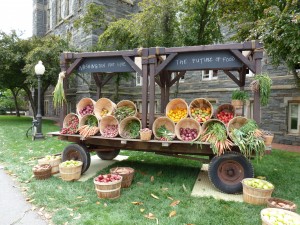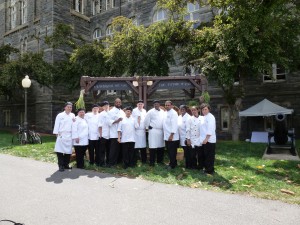Local is the Future of Food for Washington Post Conference
Bon Appétit chefs are used to cooking for business and academic royalty: CEOs, Nobel Prize-winning professors, and university presidents dine on our food daily. But when the company was invited to feed actual royalty — His Royal Highness the Prince of Wales, fresh from his son’s wedding — along with Bon Appétit CEO Fedele Bauccio, a dozen other stars of the sustainable food movement, and 750 journalists and other high-profile guests, the menu planning and food sourcing reached new heights of intensity.
The occasion was a landmark all-day conference on the “Future of Food,” hosted by the Washington Post at Georgetown University in Washington, DC. (See related story.) Bon Appétit was invited to participate by Sarah Weiner, a longtime Slow Food activist and executive director of Seedling Projects, a San Francisco based consultancy retained by the Post to help put on the event. Sarah knew that Bon Appétit’s DC chefs would pull together a seasonally appropriate, locally sourced menu fit for a king-to-be… who just happens to also be an organic farmer.
Jim Dodge, Bon Appétit’s director of special culinary programs, convened a dream team of the available DC-area chefs and asked them to submit a list of produce that would be in season at the time of the event. Jim, working with Jay Keller, Bon Appétit’s chef/manager at Gallaudet University and our regional forager, and several of the other chefs pinpointed the local small farms (within 150 miles, from Virginia to Pennsylvania) that could supply the event. Jim distributed the list of produce and asked for recipes; the chefs came back with dozens. From those, Jim composed a menu that would showcase the best of the region in late spring, and worked with Sarah to refine it.
The event was sold out, and the touch-and-go weather didn’t help planning. The team had hoped to use a grill at Georgetown for the event, but the threat of rain made keeping the menu simple a necessity. Prep took place over two long days at American University’s Tenley campus kitchen before loading the vans at 4 a.m. the day of the event and heading to Georgetown University. Once at Georgetown, the culinary team was divided into two kitchens to provide service to three rooms.
“The space was tight, but we made it happen,” says American University Executive Chef Mary Soto. There were two menus served: a sit-down, family-style lunch for 350 people and a box lunch for the remainder, served in compostable packaging. (Bon Appétit also provided a simple breakfast of a local apple and a breakfast roll made with local cheddar.) The front-of-house team, led by American University Resident District Manager Yvonne Matteson and Oracle Catering Director Paula Nielson, drew staff from cafés from Virginia to Maryland to help serve the event. Set-up also began at 4 a.m. By noon, the rooms and tables looked great, and everything was ready for the guests to arrive and begin eating.
Feedback on the meal was glowing.“You set a new standard for conference lunches. The markers of care and good taste were on it, and the menu was so unusual and transformative—simple ingredients that were impeccably fresh and prepared and presented with care,” wrote Ann Harvey Yonkers, the co-director of FreshFarm Markets, after the event.
 Among those simple ingredients was honey produced by Jay Keller’s own bees, which was served with a plate of local cheese and added to the salad dressing for its subtle sweetness. Jay has been keeping bees for more than 15 years at his home in Silver Spring, MD. He says the taste of the honey varies with what the bees are feasting on each season: dandelion season makes the lightest, sweetest honey, while tulip poplars make an intensely flavored, dark reddish syrup. The honey served at the conference was a medium blend with hints of clover and black locust.
Among those simple ingredients was honey produced by Jay Keller’s own bees, which was served with a plate of local cheese and added to the salad dressing for its subtle sweetness. Jay has been keeping bees for more than 15 years at his home in Silver Spring, MD. He says the taste of the honey varies with what the bees are feasting on each season: dandelion season makes the lightest, sweetest honey, while tulip poplars make an intensely flavored, dark reddish syrup. The honey served at the conference was a medium blend with hints of clover and black locust.
“The menu was very, very healthy,” explains Jim. “We followed our Great Expectations 3 guidelines, using grains and legumes and making them very interesting and appealing.”
Guests seemed struck by the fact there was only one meat item, lamb kebabs, on the menu. The kebabs were made from a whole local lamb that was ground just for the occasion. As delicious as they were, at least one couple thought they were unnecessary: well-known sustainable farmer and agrarian poet Wendell Berry and his wife, Tanya, both remarked to Yonkers that the vegetables were so perfect and expertly prepared that the meat would not have been missed.
Overall, “the menu really demonstrated the skill and restraint of our chefs,” says Jim. Case in point: the asparagus. “It was the first crop, just packed with flavor. You could tell it had just been picked, so we just finished it with warm butter, a little sorrel, and salt and fresh cracked pepper, to let the asparagus really shine.”
The strawberry rhubarb cobbler was perhaps the biggest hit, Jim says. “It was sweet and just right. We used field rhubarb, which is more succulent, more tangy, and has a truer rhubarb flavor, and we used local strawberries that were literally just out,” he recounted.“We had to drive to pick them up.”The fruit was served with a biscuit topping, made with locally grown and stone-ground whole-wheat flour — “extremely flavorful and nutty” — along with local butter and milk. Served with very softly whipped local cream from the same dairy, no sugar and no vanilla so the full flavor of the cream came through, the dessert had many guests wishing for seconds.
“Everyone I talked with said the same thing: the lunch was brilliant,” said Ann. Kudos to Jim, the chefs, Seedling Projects, and the supporting Bon Appétit crew for pulling off such an incredible local feast under such challenging circumstances!
